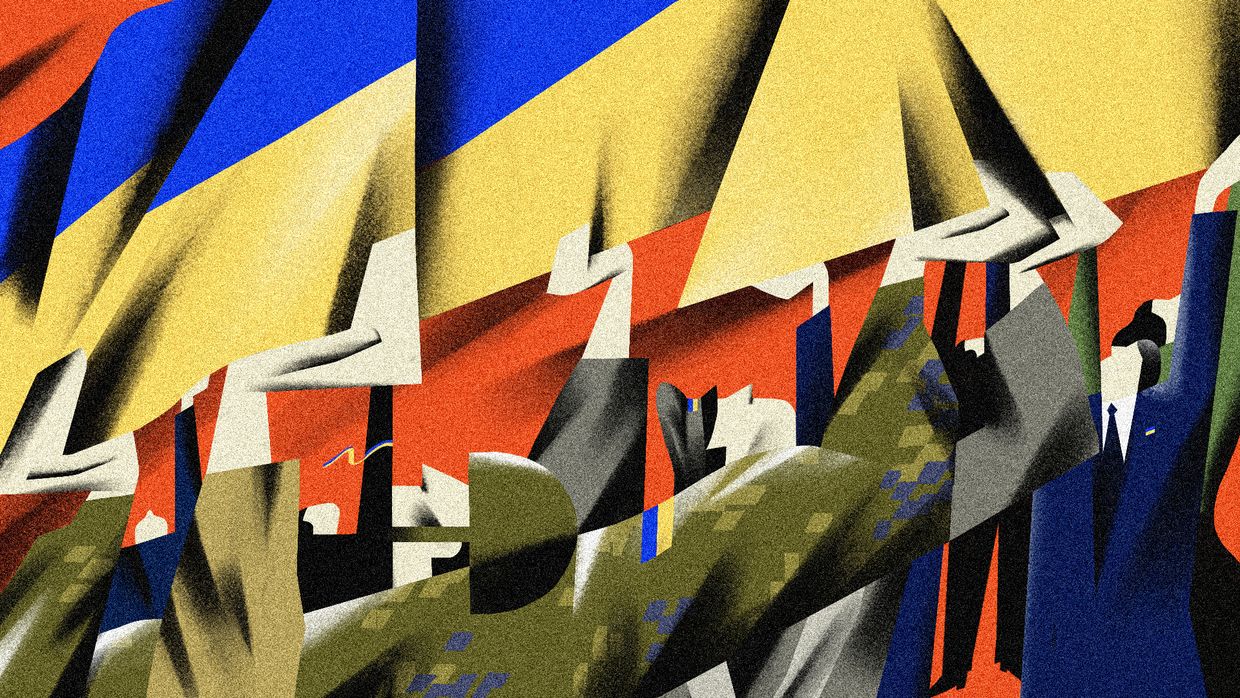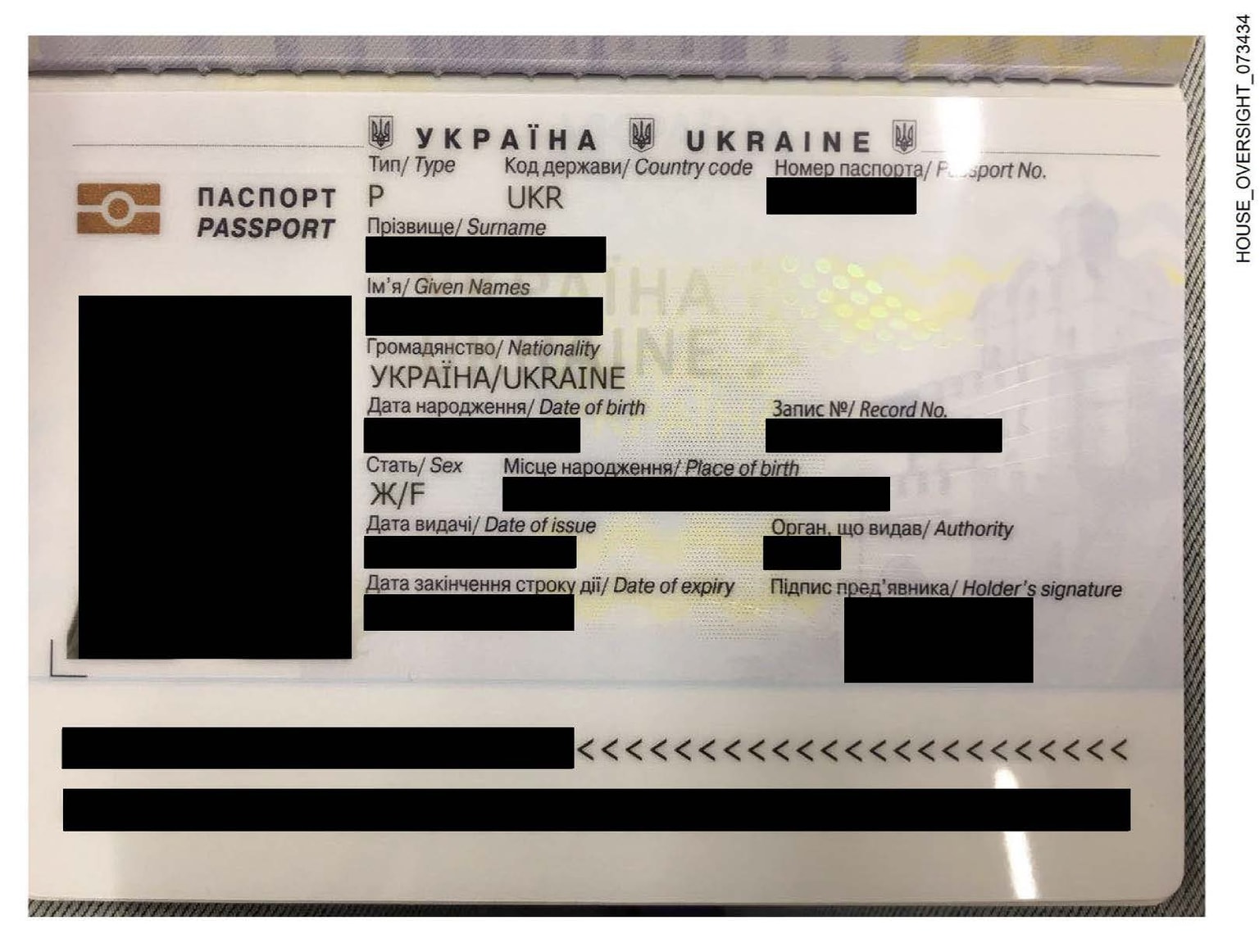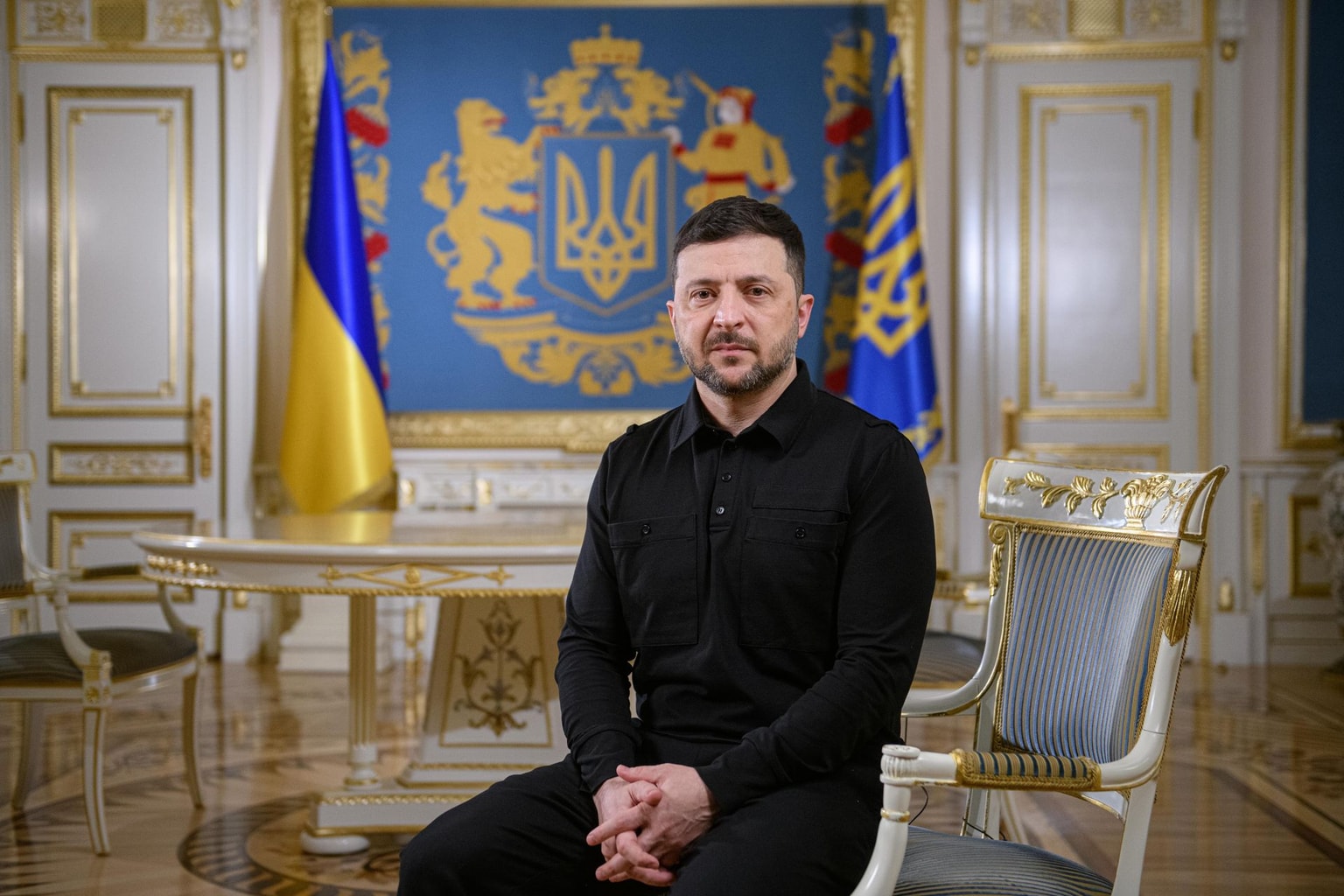Photo taken from a drone on Aug. 20, 2023 shows the Motherland monument in Kyiv, with the Ukrainian trident, or "tryzub," being installed on a shield in the statue's left hand. The Soviet hammer and sickle symbol was removed in July, amid the Russian invasion of the country. (Kyodo News via Getty Images)
Editor’s note: This article originated as a winning story idea in a vote by members of the Kyiv Independent’s community. Join our community today and join our exclusive members-only Discord channel, where you can discuss and suggest stories, ask our journalists questions, and more.
High above the green slopes of Kyiv and the broad, flowing Dnipro River, two of Ukraine's most iconic symbols stand tall: a huge blue-and-yellow flag, visible across the city, and a trident newly engraved on the steel shield of the 100-meter-tall Motherland Monument.
The trident, known in Ukrainian as tryzub, is instantly recognizable as the central element of Ukraine's modern coat of arms. But beyond its official role, the tryzub has taken on profound symbolic meaning in recent years amid Russia's full-scale invasion of Ukraine — one for which some Ukrainians have been killed or tortured simply for displaying.
Reports from occupied territories describe Russian forces strip-searching and targeting civilians for patriotic tattoos, particularly those featuring the Ukrainian flag or the tryzub. Ukrainian soldiers returning from Russian captivity have recounted beatings and torture specifically targeting those who had tryzub tattoos.
In contested towns near the front, where many locals have fled or been forced into hiding, graffiti of the tryzub signals the presence — and continued fight — of Ukrainian troops defending their homeland.
From antiquity to the 20th century: how trident became tryzub
The trident has been a symbol of power in numerous ancient cultures. It is famously associated with the Greek god Poseidon and the Hindu god Shiva, and it appears in the insignias of various modern military organizations, including the Hellenic Navy, the U.S. Navy SEALs, and the Nepalese Army.
In Ukraine, the symbol's history stretches back millennia. Archaeological evidence shows that the Cucuteni–Trypillia culture, which thrived in the 4th-3rd millennia BC in parts of modern-day western Ukraine, Moldova, and northeastern Romania, often used trident-like imagery on their pottery, which for them symbolized air, water, and earth.
More than a thousand years ago, the trident gained prominence as the ancestral sign of the ancient rulers of Kyivan Rus, particularly the Rurik dynasty. In the 10th century, seals bearing tridents were used by envoys of Prince Ihor in treaties with the Byzantine Empire. The coins of Prince Volodymyr the Great featured his portrait and a trident — his symbol of power.

Over time, various princes of the Rurik dynasty modified the trident to reflect their own identities, resulting in over 200 known variations. Archaeologists have discovered these versions on coins, seals, jewelry, bricks, and murals dating from the 10th to 12th centuries.
As Ukraine's medieval landscape changed, the trident fell out of official use. By the time it was rediscovered in the late 19th century through the excavation of Kyivan Rus coins, historians began calling it the modern-day word "tryzub."
Tryzub’s renaissance
The tryzub experienced a revival in 1917, following the collapse of the Russian Empire and the emergence of the Ukrainian People's Republic (UNR). The new republic adopted the tryzub as a national symbol and printed it on its currency — "karbovanets" — in a design by Ukrainian artist Heorhii Narbut. In 1918, the UNR officially declared it the state emblem, honoring it as "the sign of the Kyiv State of the times of Volodymyr the Holy.”
But Ukraine’s fledgling independence was short-lived. Within two years, the Soviet Red Army occupied Ukraine, ushering in decades of repression. Under Soviet rule, Ukrainian national symbols were banned, patriotism was criminalized, cultural leaders were persecuted or executed, and millions perished during man-made famines in the 1920s–1930s — events collectively known as the Holodomor.
Throughout this era, the tryzub was forbidden and labeled a nationalist threat. Yet, in exile, the Ukrainian diaspora kept the symbol alive. It appeared on the insignias of the exiled UNR government, the Organization of Ukrainian Nationalists (OUN), and various cultural and community groups.
During World War II, the Ukrainian Insurgent Army (UIA) — a military force formed by the OUN to fight for the establishment of an independent Ukrainian state — also adopted the tryzub in its fight for national independence.

After Ukraine declared independence from the Soviet Union in 1991, the tryzub entered a new era of significance. On Feb. 19, 1992, the Verkhovna Rada, Ukraine's parliament, approved it as the Small State Emblem of Ukraine, making it one of the three official state symbols.
The tryzub’s status is enshrined in Article 20 of the Ukrainian Constitution, which states that the Small State Emblem of Ukraine — a gold trident — is “the Sign of the Princely State of Volodymyr the Great," affirming the continuity of Ukrainian statehood.
What does tryzub mean?
Despite its long history, the exact origin and meaning of the tryzub remain open to interpretation. Many theories have emerged, though none are officially confirmed.
Some theories suggest it is a mystical sign of protection or a symbol of dominion over the three realms: heaven, earth, and the underworld. Others interpret it as resembling a Scythian scepter, a bow with arrows, an anchor, a crown, or a stalk of rye.
A Christian interpretation sees it as a stylized dove — a symbol of the Holy Spirit — while a popular culture theory links it to a falcon diving downwards. This imagery may stem from ancient Slavic pagan mythology, where the falcon represented a deity named Raroh. Falcons have remained a recurring motif in Ukrainian heraldry and folklore.
The official color scheme — a golden trident on a blue field — aligns with Ukraine's national colors, which date back to the Kyivan Rus era. The modern design of the tryzub is based on a 1918 version by artist Vasyl Krychevskyi, created for the Ukrainian People's Republic.
In recent years, amid Russia's ongoing war, one interpretation has especially resonated: that the shape of the tryzub contains the letters of the Ukrainian word "ВОЛЯ" as it is written with the Ukrainian Cyrillic alphabet ("volia" in English transliteration), meaning both "will" and "freedom."

















